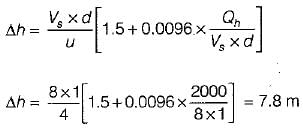Test: Air & Sound Pollution - 2 - Civil Engineering (CE) MCQ
10 Questions MCQ Test Topicwise Question Bank for Civil Engineering - Test: Air & Sound Pollution - 2
Which one of the following pollutants or pairs of pollutants is formed due to photochemical reactions?
Which of the following pairs are correctly matched?

Select the correct answer using the codes given below:

The following is a well known formula for estimating the plume rise:

where the letters have their usual meaning.
The estimated plume rise (by the above formula) with a stack gas having heat emission rate 2000 kJ/s, the wind speed 4 m/s, stack gas speed 8 m/s inside a stack diameter of 1 m at the top is

where the letters have their usual meaning.
The estimated plume rise (by the above formula) with a stack gas having heat emission rate 2000 kJ/s, the wind speed 4 m/s, stack gas speed 8 m/s inside a stack diameter of 1 m at the top is
Which one of the following procedures is used for sampling of the flue gas in a chimney for SPM?
Which one of the following units is employed for the removal of particulate matter above 50 μ in size?
Acoustics of an auditorium is considered to be excellent when its reverberation time is between
Which type of light energy is effectively absorbed by CO2 in the lower boundary of the troposphere?
Which one of the following is the correct sound intensity expression with usual notations?
What type of noise can be abated by providing lining on walls and ceiling with sound absorbing materials?
Which is the major pollutant present in photochemical smog?



















